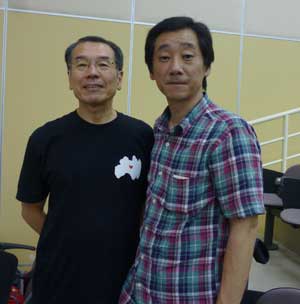Anti-Nuke Who’s Who Seiichi Nakate Nuke Info Tokyo No. 145
-I want to protect as many children as possible-
Spokesman for Fukushima Network for Saving Children from Radiation
by Eri Watanabe*
 |
|
The person on the right is Mr.Seiichi Nakate
|
“As an adult living in Fukushima Prefecture I stand here with regret. My regret about this accident that cannot be undone stretches beyond the people of Fukushima and Japan to all the people of the world.” Seiichi Nakate spoke these words in front of a group of 40 anti-nuclear activists on July 30 in Tokyo at the No Nukes Asia Forum.
Seiichi Nakate is a spokesman for the Fukushima Network for Saving Children from Radiation. This local network has started after the nuclear accident at the TEPCO Fukushima Daiichi Nuclear Power Station to actively campaign for the protection of children from radiation.
Until now the activities of the network have been a trigger in the withdrawal of the 20 millisievert limit for the usage of school yards and the introduction of the new policy as expressed by the former minister of education Takaki of aiming at 1 milisievert a year. It was 23 years ago that Mr. Nakate became aware of the risks of nuclear power and started to campaign against it. After being active for several years he decided to put more focus on his usual occupation. Last year, however, he was planning to become part of a movement for the decommissioning of unit three of the Fukushima Daiichi Nuclear Power Station, which is loaded with MOX fuel. After the accident he continued to work as an activist in order to help as many children as possible.
The first thing Mr. Nakate did after the accident was to go with three friends and measure the radiation level at school grounds. During the March spring holiday they examined seven different locations and found high levels of radiation. Several locations measured over 10 μSv/h at soil level, and at one school yard it even reached 108.8 μSv/h. With these results and the message that these levels of radiation are not safe for children, they went to the Fukushima Prefectural Education Commission. They asked the commission for the schools to postpone the traditional April opening of the school year and the placement of dosimeters at all schools in the prefecture. The prefecture decided to force through the opening of the school year, but did initiate an investigation at schools and nurseries at 1600 locations within the prefecture. They found that three-quarters of the locations measured over 0.6 μSv/h, the limit for a radiation controlled area. Moreover 20 percent of the schools crossed the line of 20 mSv/year (2.3 μSv/h). Although the prefecture released the statistics on its homepage, most people did not know how to interpret the numbers. Mr. Nakate and his friends summarized the numbers and assessed them. They had to give the regrettable explanation that three-quarters of Fukushima’s children were faced with radiation levels equal to people working at a nuclear power plant.
On May 1, Mr. Nakate and others called a meeting in Fukushima City, and with a group of parents founded the Fukushima Network for Saving Children from Radiation. The network grew rapidly and at present there are groups supporting the network all over Japan. Lately action has been started to get Fukushima City’s Watari district, where Mr. Nakate lives, to be recognized by the state as a “specific evacuation recommendation spot.” This would mean that those who voluntarily evacuate from the region are entitled to support for their evacuation. It has been pointed out that the area in the district were the radiation is higher than 20 mSv/year is expanding. However further investigations by the government are taking time and a decision has been postponed.
In the meanwhile, attempts at decontamination have had little effect and some places have even seen a rise in radiation. Fukushima City, just as in Minami Soma City, has no standard criteria on radiation for pregnant women and children. Therefore children in the Watari district are forced to live in areas where they receive high doses of radiation.
Mr. Nakate has reiterated that “When children collapse from disease it is too late to evacuate. Before that happens, all who should evacuate need to be enabled to do so. ” Mr. Nakate’s wife and two children have evacuated to Okayama (Western Japan). It is not hard to imagine that living in separate places is causing their family a lot of stress. Despite this, Mr. Nakate knows how to negotiate with the government in a calm and serious manner as a gentleman. At present he is continuing actions to extend support and opportunities to evacuate all the people who should do so as quickly as possible.
*Eri Watanabe, NGO Friends of the Earth Japan

